Why Choose These Alpaca Breeds for Fiber Quality?
You’d choose Huacaya and Suri alpaca breeds because their distinct genetics give you fibers with unmatched softness and durability. Huacaya offers fluffy, crimped fiber perfect for cozy garments, while Suri provides silky, lustrous locks ideal for luxury textiles. Their fiber quality depends on genetics and care, including balanced nutrition and selective breeding. Understanding these differences helps you pick the best fiber for your needs, with more insights waiting as you explore their unique qualities further.
Key Takeaways
- Huacaya alpacas produce fluffy, crimped fibers ideal for warm, cozy textiles, making them a popular choice for quality fiber.
- Suri alpacas yield silky, straight, and lustrous fibers suited for luxury and high-end fashion applications.
- Royal alpacas offer exceptionally fine fibers under 20 microns, providing superior softness for premium textile products.
- Selective breeding enhances fiber traits like density and uniformity, ensuring consistent high-quality fleece from chosen breeds.
- Proper nutrition tailored to alpaca breeds supports optimal fiber fineness, durability, and luster, maximizing fiber quality.
Understanding Huacaya and Suri Alpaca Fibers
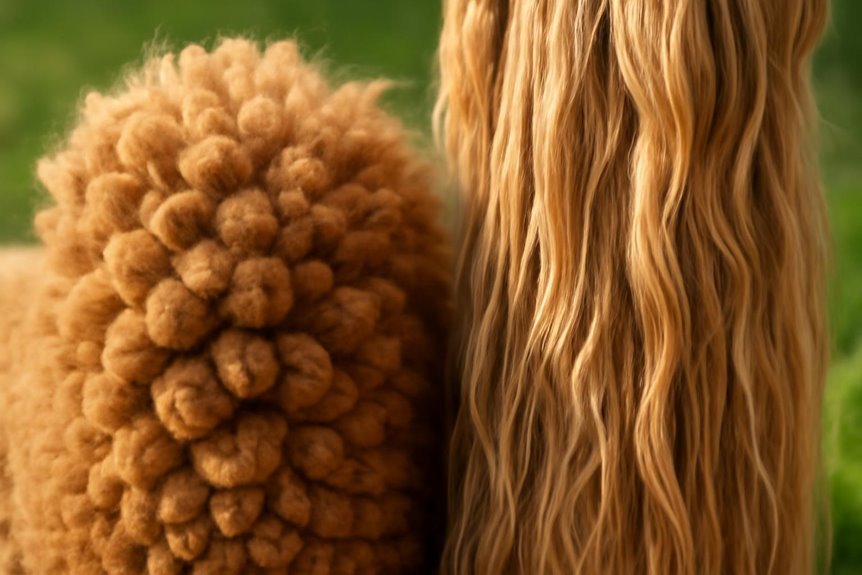
Although Huacaya and Suri alpacas differ considerably, understanding their fibers can help you choose the right material for your needs. Huacaya alpaca fiber, which makes up about 90% of the global population, is fluffy, crimped, and elastic. This elasticity provides excellent insulation, making Huacaya ideal for warm garments like sweaters and scarves. On the other hand, Suri alpaca fiber, representing around 10%, is silky, straight, and lustrous. Its smooth texture closely resembles cashmere and offers a beautiful drape, perfect for luxury wraps and outerwear. While Huacaya fiber is typically 20 to 26 microns thick, Suri can be finer, ranging from 15 to 25 microns. Knowing these differences helps you select the perfect alpaca fiber for everyday comfort or elegant fashion.
Key Fiber Characteristics Influenced by Breed
When choosing alpaca fiber, you’ll find that the breed greatly influences key characteristics like texture, softness, and warmth. Huacaya alpaca fiber, making up about 90% of the population, boasts a fluffy, crimped texture that traps heat effectively, offering superior insulation. This quality fiber is perfect for cozy garments like sweaters and scarves due to its elasticity and loftiness, making it 3 to 4 times more insulating than many other fibers. On the other hand, Suri fiber, though less common, features silky, straight locks with a smooth, lustrous feel ideal for luxurious wraps. Understanding these breed-specific traits helps you select alpaca fiber products that best match your comfort needs and style preferences, ensuring you get the highest quality fiber for your wardrobe.
The Role of Genetics in Alpaca Fiber Quality
Since genetics determine key traits like fiber diameter and texture, they play an essential role in alpaca fiber quality. The micron count, which measures fiber fineness, is heavily influenced by genetics; for example, royal alpacas boast fibers under 20 microns, making their fleece exceptionally soft and luxurious. You’ll notice that Huacaya and Suri breeds differ genetically, with Huacaya producing fluffy, crimped fibers and Suri offering silky, lustrous locks. By selecting alpacas for breeding based on fiber density, staple length, and fleece uniformity, you can enhance their genetic potential and consistently improve fiber quality in your herd. Understanding your alpacas’ genetic lineage helps you target specific traits, ensuring you breed animals that meet the high standards demanded in luxury textile production.
Nutrition’s Impact on Fiber Fineness and Durability
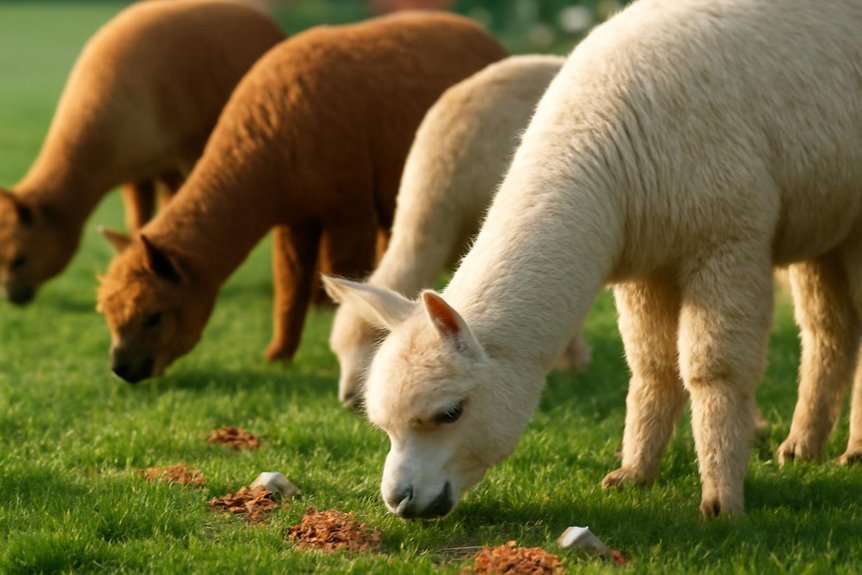
Because nutrition directly affects the health of your alpacas, it plays an essential role in the fineness and durability of their fiber. Providing balanced nutrition guarantees alpaca fiber offers the finest micron counts and lasting strength. Quality nutrition—including the right types of hay and supplements—boosts fleece luster and shine, which enhances market value. However, overfeeding or improper feeding can coarsen the fiber, so managing a precise nutrition program is vital. Combining genetics with proper nutrition supports fiber follicle development, resulting in superior fleece quality. Regularly evaluating feed content, such as using Mazuri products, improves overall alpaca health and fiber characteristics. By focusing on nutrition, you’re directly influencing the quality and durability of the alpaca fiber your herd produces.
Breeding Practices for Superior Fiber Production
When you focus on selective breeding, you can enhance key traits like fiber fineness and density in both Huacaya and Suri alpacas. Paying close attention to genetics helps you produce fleece with the ideal micron diameter and staple length for softness and durability. Plus, maintaining excellent nutrition guarantees the fiber’s texture and appearance stay exceptional throughout the breeding process.
Selective Breeding Strategies
Although selective breeding may seem complex, focusing on key traits like micron diameter, density, and fiber architecture can help you produce alpacas with superior fleece quality. When working with Huacaya and Suri breeds, selective breeding means choosing animals with proven genetics that consistently yield fine, soft fibers. You’ll want to regularly evaluate fleece characteristics such as staple length and luster to guide your pairing decisions. Nutritional management also plays a crucial role—providing high-quality feed supports your alpacas’ health and improves fiber fineness. By combining careful genetic selection with proper nutrition, you can steadily enhance your herd’s fiber quality. Following expert advice and industry standards will make your selective breeding efforts more effective, ensuring your alpacas produce premium fleece for textile use.
Genetic Traits Emphasis
If you want to breed alpacas that produce superior fiber, focusing on key genetic traits is essential. Prioritizing these traits helps guarantee your animals develop fleece with outstanding qualities. By selecting for specific genetic markers, you can enhance fiber softness, strength, and overall market value. Keep in mind that genetic traits work best when paired with proper nutritional management, which supports fiber follicle development. To emphasize superior fleece quality, concentrate on:
- Fine micron counts for softness
- Dense fiber for warmth and durability
- Luster reflecting fiber shine
- Organized lock structure enhancing texture
- Breed-specific traits like Huacaya’s crimp or Suri’s silkiness
This strategic breeding approach optimizes your alpacas’ fiber production, setting you up for success in the textile market.
Nutrition’s Role Impact
Genetics lay the foundation for superior alpaca fiber, but nutrition plays a key role in bringing out those traits to their fullest potential. Proper nutrition directly influences the fineness, density, and uniformity of your alpaca’s fleece. By providing a balanced diet rich in quality hay and supplements like those from Mazuri, you support your alpaca’s overall health and enhance fiber shine and texture. Overfeeding or incorrect feed can coarsen the fiber, so managing nutrition carefully is essential. Research shows that a tailored nutrition program improves fiber follicle development, leading to exceptional fleece quality. To get the best fiber from your alpacas, you need to combine good breeding with smart nutrition practices that optimize the animals’ well-being and fleece appearance.
Matching Fiber Types to Textile Applications
When you choose alpaca fiber for textiles, understanding the distinct qualities of each type helps you match the fiber to its best use. Huacaya alpaca fiber, fluffy and elastic, suits warm, cozy garments like sweaters. Suri alpaca fiber’s silky, lustrous texture fits luxury wraps and high-end fashion. Royal Alpaca, with its ultra-fine micron count, is perfect for premium soft textiles. Consider these points when selecting fiber:
Choosing alpaca fiber wisely enhances your textile’s warmth, softness, and luxury appeal.
- Huacaya for insulation and elasticity
- Suri for sheen and elegance
- Baby alpaca for softness and durability
- Royal Alpaca for luxury softness under 20 microns
- Coarser alpaca wool for robust outerwear
Frequently Asked Questions
What Is Unique About Alpaca Fiber?
You’ll love alpaca fiber characteristics like softness, warmth, and hypoallergenic benefits. Its uses range from cozy garments to luxury textiles, offering breathable insulation and sustainability, making it perfect for sensitive skin and eco-conscious choices you’ll appreciate.
Why Is Alpaca Fiber a Good Choice for Making Clothing?
Imagine wrapping yourself in clouds; alpaca fiber’s softness properties caress your skin while thermal insulation keeps you warm. Plus, its moisture-wicking ability guarantees you stay dry and comfortable, making it perfect for clothing you’ll love wearing.
What Is the Best Alpaca Fiber?
The best alpaca fiber depends on your needs—Huacaya offers fluffy warmth, while Suri provides silky softness. You’ll love the wide alpaca color variations, fiber softness comparison, and sustainable fiber production that make each unique and eco-friendly.
What Is the Best Type of Alpaca?
You’ll find about 90% of alpacas are Huacaya, offering fluffy fiber that’s easier for alpaca care. Knowing breed differences and fiber characteristics helps you pick the best type for your needs and lifestyle.

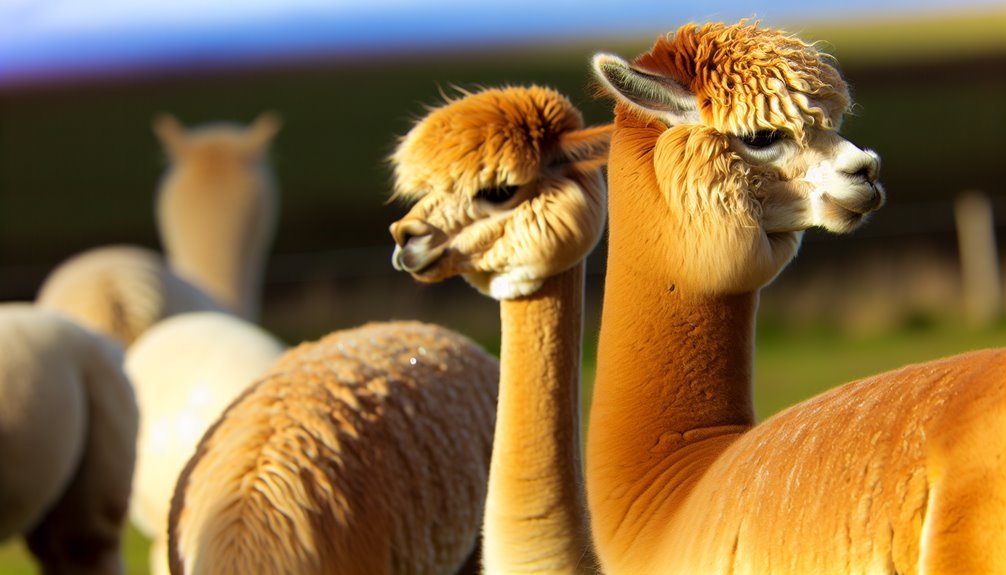
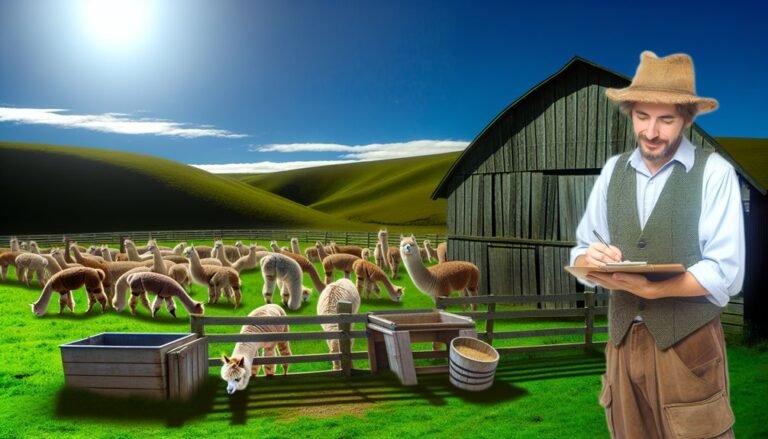



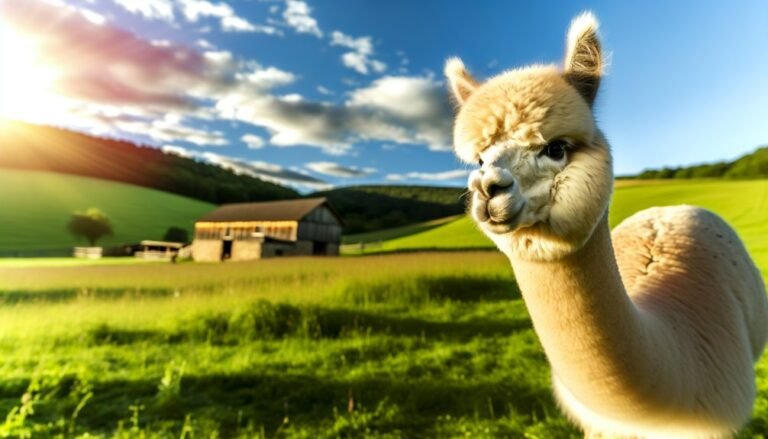

Our picks
Alpaca & Wool Felted Sole Inserts: Comfy Upgrade?
Best Alpaca Socks for Hiking: Ultimate Comfort and Durability on Trails
Best Alpaca Halter for Comfort and Control